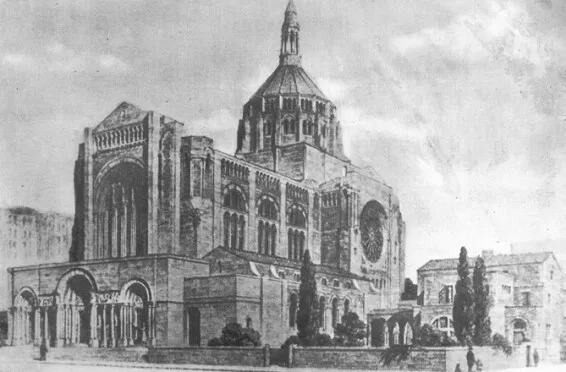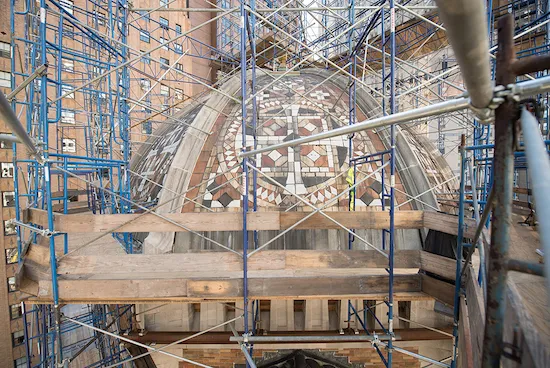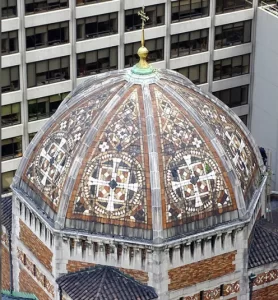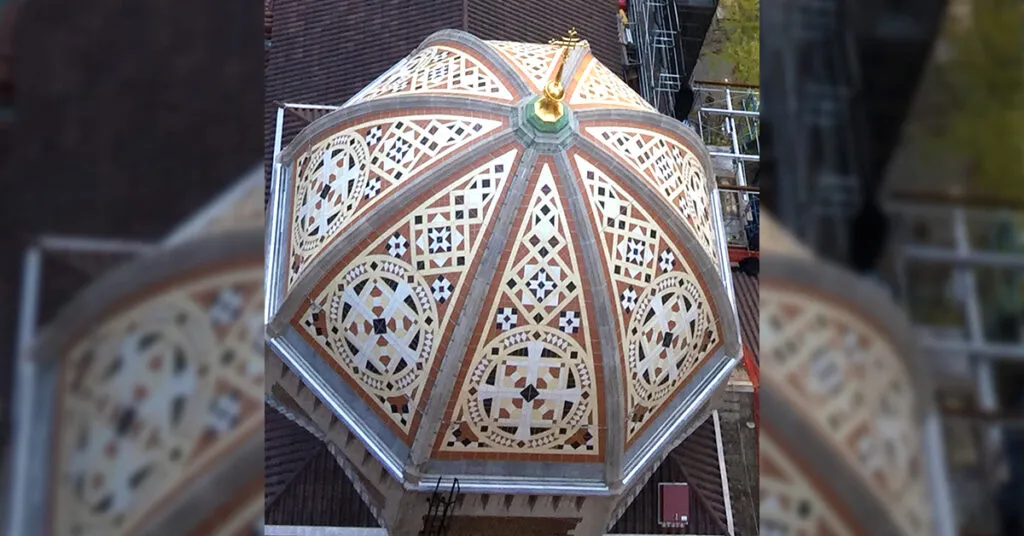St. Bartholomew Episcopal Church stands proudly as one of New York’s noteworthy historical, architectural, and cultural landmarks. Serving both as a center of worship and a cultural hub for the community, St. Barts (as it is commonly known) has played a significant role in developing Manhattan’s historical and cultural landscape.
Adorned with intricate mosaics, detailed interior features, and the standout great Dome on top of the structure, St. Bartholomew Episcopal Church is a visual marvel in the heart of New York City at Park Avenue.
Restoring the great Dome of St. Bartholomew’s Episcopal Church is no small feat, given the intricacy of its design and architecture. The complexity of the task demands experienced and meticulous workmanship, making Graciano an ideal choice for the project. We were honored to be awarded the restoration project for this 100-year-old Dome in 2016.
Continue reading to explore the details of our restoration project for the historic Dome at St. Bartholomew Episcopal Church.
Historical Background of St. Bartholomew Episcopal Church
St. Bartholomew Episcopal Church, founded in 1835, had humble beginnings, with worship services held in a simple church at the corner of Great Jones Street and Lafayette Place.

As the congregation grew, the church underwent significant developments. By 1872, it moved to a new location at Madison Avenue and 44th Street, with a newly built Church designed by the architect James Renwick.
Over time, structural issues arose at the Madison Avenue location, prompting the parish to enlist Bertram Goodhue, one of America’s prominent architects, to design and build the St.Barts church at the current location, Park Avenue. Today, St. Bartholomew Episcopal Church has been designated a National Historic Landmark and is next to another Graciano project, the Waldorf Astoria.
The Architectural Legacy of Bertram Grosvenor Goodhue
Bertram Goodhue is a well-known figure in American architecture, particularly renowned for his expertise in ecclesiastical structures.
 His influence is broad, drawing from Romanesque, Gothic, and Spanish styles, evident through his notable works, including the Nebraska State Capitol, the campuses of Rice and Princeton Universities, the 1915 Panama-California Exposition, and the St. Bartholomew’s Episcopal Church.
His influence is broad, drawing from Romanesque, Gothic, and Spanish styles, evident through his notable works, including the Nebraska State Capitol, the campuses of Rice and Princeton Universities, the 1915 Panama-California Exposition, and the St. Bartholomew’s Episcopal Church.
One of the grand features of St. Barts, envisioned by Goodhue, was the great Dome. Initially conceived as a tall tower enclosing a dome rising above the crossing, Goodhue passed away in 1924 before the project’s completion.
His associates’ successors carried on, and the Dome was ultimately finished based on Goodhue’s design for the Dome of the California State Building at the Panama-California Exposition in San Diego. This grand Dome, a remarkable part of the church, sits atop a square base integrated with the church’s structure and consists of two domes, one inside the other.
Graciano: Restoring the 100-Year-Old Dome
Our team knew restoring the 100-year-old St. Bart’s Dome would be very challenging, especially knowing the project’s scope, which needed to dismantle and rebuild the whole Dome and complete every task in compliance with the demanding historical specifications.

The Dome has eight exterior planes decorated with colored marble, terra cotta, and granite tile and crowned with a gilded cross.
Our team started with a survey, which required our team to rappel down and across to take measurements and samples of the exterior. Based on our careful survey, we devise a customized strategy that utilizes the latest technology and traditional craftsmanship.
Our restoration programs for the St. Barts dome include removing and replacing over 6300 terra cotta tiles, installing steel-reinforced waterproof mortar, recreating the original mosaic tile patterns, and replacing the cementitious and waterproof surface underlayment.
Our team was also in charge of selecting masonry stone and terra cotta tile roof repairs and replacements.
Giving a Future to the Past: The Importance of Restoration
Restoration plays a vital role in safeguarding history and cultural identity, often manifested in the intricate architecture of buildings and landmarks. These structures bring with them treasures from the past–stories of bygone cultures, their lifestyle, and the craftsmanship evident in the design intricacies and construction techniques.

Restoring these buildings helps maintain a tangible link between the past and the present, ensuring that the rich history endures for future generations to enjoy and appreciate.
Furthermore, restoration often involves carefully integrating modern features while preserving the original structure and charm. This approach ensures the structures remain relevant and resilient, ready to meet the challenges of our work.
End Note
From its modest beginnings to its current role as a place of worship, cultural hub, and breathtaking marvel, St. Bartholomew Episcopal Church stands tall as one of New York’s designated national landmarks, steeped in history and significance.
Graciano, equipped with expertise and extensive experience in the field of restoration, took on the prestigious project of restoring a vital feature of the church—the grand Dome. Through our unwavering dedication and hard work, we breathed new life into the Dome, giving the church a resilient and magnificent presence for all to appreciate.
If you need any assistance in restoration work, let our portfolio and numerous awards speak for our capabilities. Graciano is your trusted restoration partner! Call us, and we will ensure that our future collaboration will be one for the books.

